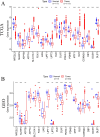Identification and characterization of cuproptosis related gene subtypes through multi-omics bioinformatics analysis in breast cancer
- PMID: 39945992
- PMCID: PMC11825418
- DOI: 10.1007/s12672-025-01952-2
Identification and characterization of cuproptosis related gene subtypes through multi-omics bioinformatics analysis in breast cancer
Abstract
Cuproptosis, a newly suggested mechanism of controlled cellular demise, which has been extensively associated with aspects of occurrence and development in breast cancer. The aim of this study was to conduct a comprehensive multi-group bioinformatics analysis based on the expression of cuproptosis-related genes (CRGs) to identify novel breast cancer subtypes to guide clinical practice. We collected TCGA-BRCA and GSE42568 datasets to investigate the expression patterns of CRGs in breast cancer. Consensus cluster analysis was performed to identify distinct subtypes. Subsequently, an investigation was carried out to examine the disparities between CRGclusters through functional enrichment analysis. Finally, we examined microsatellite instability, tumor mutation burden, drug sensitivity, infiltration of immune cells and cancer cell stemness across different CRGclusters. We identified two subtypes, where CRGcluster S2 exhibits a poorer prognosis compared to CRGcluster S1. Moreover, CRGcluster S2 demonstrated lower immune infiltration scores, higher cancer cell stemness index, and increased tumor mutation burden relative to CRGcluster S1, with the most frequently mutated gene being ATP7A. Notably, breast cancer chemotherapy drugs such as docetaxel, doxorubicin, and paclitaxel exhibited reduced sensitivity towards CRGcluster S2 when compared to CRGcluster S1. We have identified two CRGclusters in breast cancer that could serve as potential therapeutic targets and warrant further investigation in clinical trial studies for breast cancer.
Keywords: Bioinformatics; Breast cancer; Cuproptosis; Drug sensitivity; Multi-omics.
© 2025. The Author(s).
Conflict of interest statement
Declarations. Ethics approval and consent to participate: The samples utilized in this study were obtained from publicly available online databases, thus exempting the need for ethical approval. Consent for publication: Not applicable. Competing interests: The authors declare no competing interests.
Figures









Similar articles
-
Identification of cuproptosis-related subtypes, construction of a prognosis model, and tumor microenvironment landscape in gastric cancer.Front Immunol. 2022 Nov 21;13:1056932. doi: 10.3389/fimmu.2022.1056932. eCollection 2022. Front Immunol. 2022. PMID: 36479114 Free PMC article.
-
Comprehensive analysis of cuproptosis-related genes and tumor microenvironment infiltration characterization in breast cancer.Front Immunol. 2022 Oct 20;13:978909. doi: 10.3389/fimmu.2022.978909. eCollection 2022. Front Immunol. 2022. PMID: 36341328 Free PMC article.
-
Identification of cuproptosis-related subtypes, establishment of a prognostic model and tumor immune landscape in endometrial carcinoma.Comput Biol Med. 2022 Oct;149:105988. doi: 10.1016/j.compbiomed.2022.105988. Epub 2022 Aug 20. Comput Biol Med. 2022. PMID: 36007289
-
Comprehensive analysis of a cuproptosis-related ceRNA network implicates a potential endocrine therapy resistance mechanism in ER-positive breast cancer.BMC Med Genomics. 2023 May 5;16(1):96. doi: 10.1186/s12920-023-01511-0. BMC Med Genomics. 2023. PMID: 37143115 Free PMC article.
-
Identification of a novel cuproptosis-related gene signature and integrative analyses in patients with lower-grade gliomas.Front Immunol. 2022 Aug 15;13:933973. doi: 10.3389/fimmu.2022.933973. eCollection 2022. Front Immunol. 2022. PMID: 36045691 Free PMC article. Review.
Cited by
-
Comprehensive analysis and experiment validation of five cuproptosis-related genes in prognosis, immune infiltration and metabolic characterization of pancreatic cancer.PLoS One. 2025 May 14;20(5):e0323458. doi: 10.1371/journal.pone.0323458. eCollection 2025. PLoS One. 2025. PMID: 40367233 Free PMC article.
References
-
- da Costa Nunes GG, de Freitas LM, Monte N, Gellen LPA, Santos AP, de Moraes FCA, da Costa ACA, de Lima MC, Fernandes MR, Dos Santos SEB, et al. Genomic variants and worldwide epidemiology of breast cancer: a genome-wide association studies correlation analysis. Genes. 2024. 10.3390/genes15020145. - PMC - PubMed
-
- Sung H, Ferlay J, Siegel RL, Laversanne M, Soerjomataram I, Jemal A, Bray F. Global cancer statistics 2020: GLOBOCAN estimates of incidence and mortality worldwide for 36 Cancers in 185 Countries. CA Cancer J Clin. 2021;71:209–49. - PubMed
-
- Gradishar WJ, Moran MS, Abraham J, Abramson V, Aft R, Agnese D, Allison KH, Anderson B, Burstein HJ, Chew H, et al. NCCN Guidelines(R) insights: breast cancer, version 4.2023. J Natl Compr Canc Netw. 2023;21:594–608. - PubMed
Grants and funding
- AB240210/Science and Technology Plan Projects in Hechi
- AB240210/Science and Technology Plan Projects in Hechi
- AB240210/Science and Technology Plan Projects in Hechi
- Z-A20231153/The Guangxi Zhuang Autonomous Region Health Committee Self-financing Scientific Research Subject
- Z-A20231153/The Guangxi Zhuang Autonomous Region Health Committee Self-financing Scientific Research Subject
LinkOut - more resources
Full Text Sources
